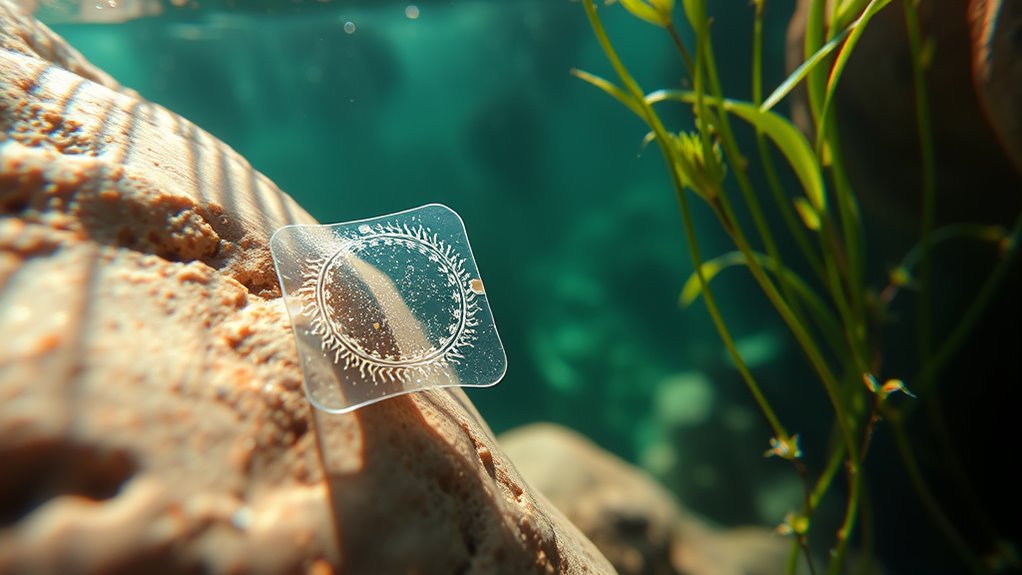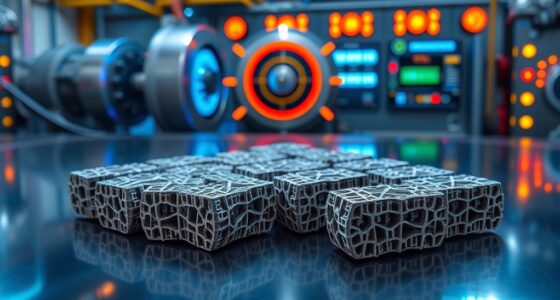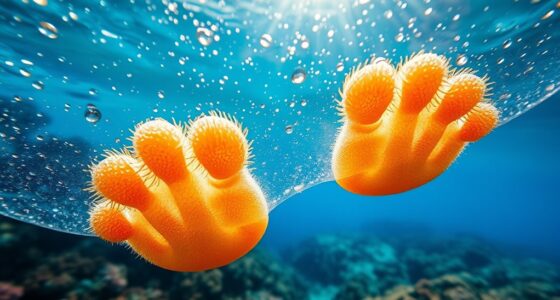Scientists have created underwater adhesives inspired by geckos’ natural ability to cling without glue. By mimicking the microscopic structures of setae and spatulae, these biomimetic materials use physical forces like van der Waals interactions to bond securely in wet conditions. Unlike traditional adhesives, they work effectively underwater, making them ideal for marine repairs and medical applications. If you keep exploring, you’ll discover how these innovations could transform various industries and solve longstanding adhesion challenges.
Key Takeaways
- Researchers replicate gecko’s nanoscale footpad structures to develop synthetic adhesives effective in wet and underwater environments.
- These biomimetic adhesives utilize physical van der Waals forces, maintaining strong bonds without chemical adhesives that fail when wet.
- Advances include lightweight, reusable materials capable of adhering to various surfaces submerged in water.
- Such underwater adhesives are promising for marine repair, underwater construction, and medical applications like wound closure.
- This breakthrough leverages biological insights to create durable, water-resistant adhesives that outperform traditional chemical-based options.

Scientists have achieved a remarkable breakthrough in biomimicry, harnessing nature’s innovations to solve complex human problems. One of the most exciting developments involves mimicking the way geckos stick to surfaces, especially their ability to maintain adhesion even underwater. This innovation opens up new possibilities for adhesives that work reliably in wet or submerged environments, which has long been a challenge in materials science. You might not realize it, but gecko adhesion is a marvel of natural engineering. Geckos have millions of tiny hair-like structures called setae on their footpads, which split into even smaller spatulae. These microscopic features allow them to exploit van der Waals forces—weak electromagnetic attractions—enabling them to cling to surfaces without glue or adhesives. Scientists have studied these mechanisms intensely, aiming to replicate their effectiveness in synthetic materials.
Scientists mimic gecko feet to create underwater adhesives using natural nanostructures and van der Waals forces.
What makes this breakthrough particularly compelling is its potential application in underwater bonding. Traditional adhesives often fail when exposed to moisture because they rely on chemical bonds that are disrupted by water molecules. But geckos don’t need chemical adhesives—they leverage physical interactions, which are less affected by water. By mimicking the structure and mechanics of gecko setae, researchers are designing new adhesives that can perform underwater, sticking securely to a variety of surfaces without losing strength. Imagine using such adhesives in underwater construction, marine repair, or even in medical procedures involving wet tissues. These biomimetic adhesives could eliminate the need for invasive procedures or complicated drying processes, making repairs faster, more efficient, and less damaging.
You might be surprised to learn how these innovations are progressing from laboratory experiments to real-world applications. Engineers have created synthetic adhesives that emulate gecko adhesion, demonstrating impressive underwater bonding capabilities. These materials are lightweight, reusable, and capable of maintaining adhesion despite the presence of water. This progress is driven by an understanding of the physical principles behind gecko adhesion, combined with advances in nanotechnology and material science. As a result, you could soon see these biomimetic adhesives used in diverse fields—from repairing pipelines and underwater structures to developing new types of medical tapes or bandages that work flawlessly in moist environments. Additionally, the development of these adhesives relies heavily on insights from natural engineering, which underscores the value of studying biological systems for technological innovations.
In essence, this biomimicry breakthrough not only showcases the ingenuity of nature but also paves the way for innovative solutions to longstanding challenges. By learning from gecko adhesion and underwater bonding, scientists are creating adhesives that are stronger, more versatile, and environmentally friendly. This progress promises to revolutionize industries where reliable adhesion in wet conditions is critical, transforming how we approach repairs, construction, and healthcare. The future of underwater bonding, inspired by a tiny reptile’s remarkable feet, is already taking shape, offering solutions that once seemed impossible.
Frequently Asked Questions
How Durable Are Underwater Gecko-Inspired Adhesives Over Time?
You might wonder about the durability of underwater gecko-inspired adhesives over time. These adhesives generally exhibit good long-term stability, but material degradation can occur due to constant exposure to water, pressure, and environmental factors. While they’re designed for durability, their longevity depends on application conditions and materials used. Regular testing and ongoing research help improve their lifespan, ensuring they maintain stickiness and effectiveness over extended periods.
Can These Adhesives Be Reused Multiple Times Without Losing Effectiveness?
Imagine testing the reusability of these adhesives through longevity testing to see if they maintain effectiveness over multiple uses. You find that reusability concerns are valid; some adhesives lose stickiness after several applications. Although innovations aim to improve durability, ongoing research is essential. For now, you should expect some decline in performance with repeated use, but future advancements may enhance their longevity and reusability.
Are There Environmental Concerns With Manufacturing Biomimetic Adhesives?
You should consider the environmental footprint of manufacturing biomimetic adhesives, as it impacts sustainability. The manufacturing impact can involve energy use, material sourcing, and waste production, which may raise concerns about pollution and resource depletion. While these adhesives offer eco-friendly benefits during use, it’s essential to evaluate their entire life cycle to guarantee they don’t contribute unnecessarily to environmental harm. Reducing manufacturing impact is key to their overall sustainability.
How Do These Adhesives Perform on Different Underwater Surfaces?
Imagine these adhesives as underwater chameleons, adapting seamlessly to their environment. You’ll find they perform well across various surfaces, but surface texture can influence their grip—rougher textures may offer more hold, while smoother ones challenge adhesion. Chemical compatibility also plays a role; some surfaces react better with specific formulations. With the right tweak, these adhesives can cling to diverse underwater surfaces, making them versatile tools in aquatic environments.
What Are Potential Medical Applications for Underwater Gecko-Inspired Adhesives?
You can see that underwater gecko-inspired adhesives open exciting medical possibilities, like wound closures and tissue repairs. However, you’ll face biocompatibility challenges to guarantee they’re safe inside the body. Regulatory hurdles also need to be addressed before they become standard in medical use. Overcoming these issues requires rigorous testing and approval processes, but the potential benefits make it a promising area to watch.
Conclusion
Now that you’ve seen how gecko-inspired adhesives are revolutionizing underwater adhesion, imagine what’s next. Could this breakthrough release even more incredible applications, from deep-sea exploration to medical devices? The possibilities are vast, and the future holds surprises you won’t want to miss. As scientists push boundaries, one thing’s clear: this biomimicry marvel is just the beginning. Stay tuned—you won’t believe what’s coming next in this underwater adhesive revolution.










